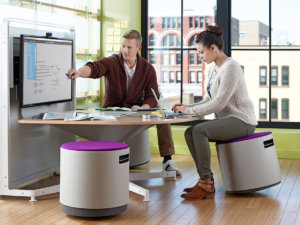The Workplace of the Future
Digital technology is transforming even our physical work spaces.
Topics
Social Business
Thanks to digital technology, business is evolving into an office-less enterprise that’s more mobile and fluid than the “desk jobs” of decades past — which presents a challenge to the companies that supply businesses with the nuts-and-bolts of their physical infrastructure. One company, Steelcase, has risen to this challenge by changing how they conceptualize the physical environs of the workplace. In an interview with MIT Sloan Management Review guest editor Gerald C. (Jerry) Kane, Steelcase vice president Sara Armbruster explains, “For us, we’re always asking questions about how work is changing and what that means — and what we can bring to the physical environment to support those changes and the people who are doing that work.”
Many readers might think — Steelcase is just an office furniture company; what do they have to do with digital business?
Our business is really about understanding work, worker and workplace, and the pursuit of bringing solutions to that workplace.
We ask ourselves questions all the time around how people can interact with each other and engage in content together seamlessly and synchronously, and how content can transform from digital to analog and back and forth. We want to understand what people’s expectations are in this world of digital technology — social, mobile, analytics, etc. — and what implications that has on the way work happens and the physical environment that is required to support it.
Can you give us some concrete examples of how you’re helping this physical environment be more sensitive to digital trends?
Digital tools are changing how work happens. One place we see this is in the area of communications. For example, the use of video communication tools that support distributed teams or distributed work has exploded. But in many cases, there is still a long way to go before those tools make this form of collaboration and communication seamless.
For example, one of the consistently nagging problems our research has uncovered is that organizations face “presence disparity,” meaning that collaboration is not seamless between distributed teams.

